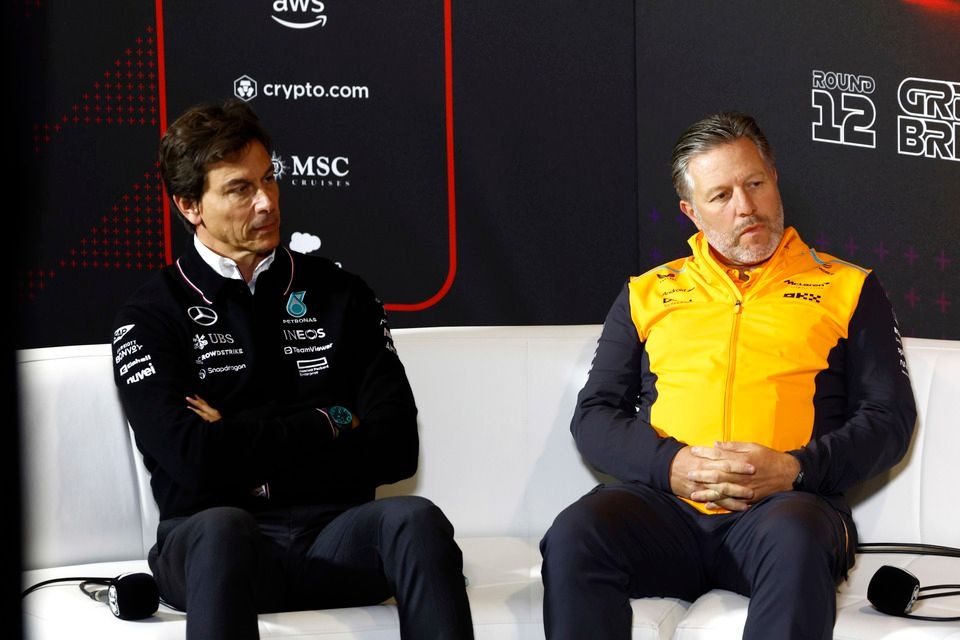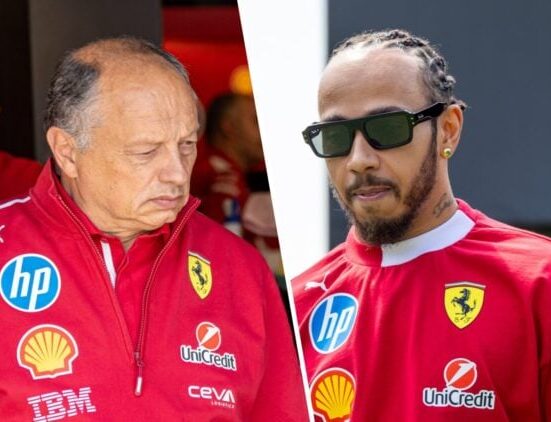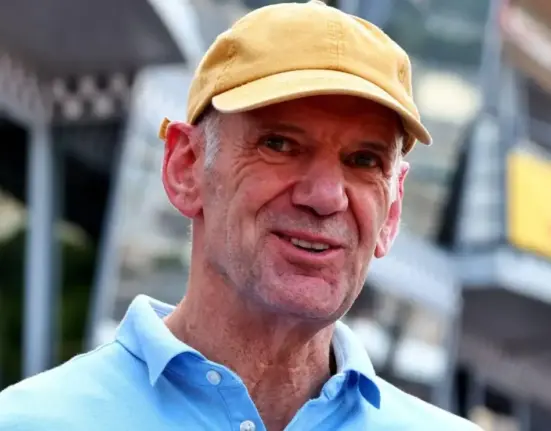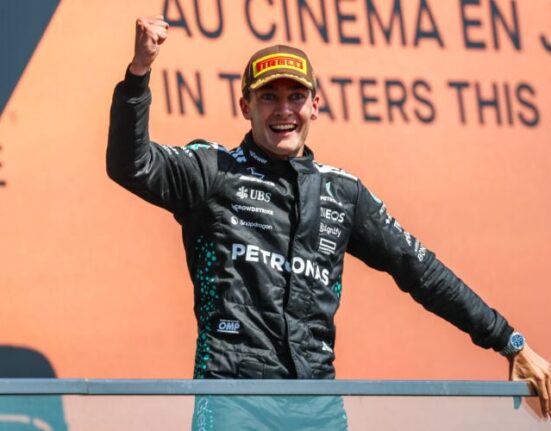In Bahrain, the focus in the Formula 1 paddock was a high-level meeting about the future engine formula and the 2026 regulations. The meeting was held after a media session with Nikolas Tombazis in China, in which the director of the FIA’s single-seater commission raised two major questions.
First of all, what does F1’s long-term engine formula look like? If the answer is a V10 with sustainable fuels in 2031, or even before that, then the second question is: what should happen before then? The FIA put two options on the table during that media session: shorten the cycle of the 2026 regulations, or scrap those rules.
The main conclusion of the meeting that followed with manufacturers is, as expected, that the latter will not happen. Motorsport.com understands that three brands made it very clear from the beginning of the meeting that they would not accept it. Guessing who voiced this stance is not difficult – Audi and Honda joined (or stayed in) F1 because of electrification and regulations that align with their sustainability goals. Mercedes expressed its opinion as well, both before and during the meeting. Toto Wolff has repeatedly stated that F1 must be “a reliable partner” and that changing regulations at the last minute does not fit that description.
In the Bahrain meeting, Daimler CEO Ola Kallenius (who joined virtually) spoke early on and took a similar stand. With Audi and Honda against scrapping the new regulations, this idea was quickly taken off the agenda, as a supermajority was required for any changes. If just one manufacturer had been against it, ratifying it would have been possible, but still unwanted: the FIA emphasised via Tombazis that any changes had to be based on “broad consensus”.
What is the future? Turbo, KERS, and other points of contention
However, there was much more to discuss — both about the 2026 regulations and the question of what the engine of the future should look like. In its following statement, the FIA made clear that “a degree of electrification will always be part of future considerations”.
One of the options that has been mentioned a lot is a V10 or V8 with KERS, but it’s not that simple in practice, as this technology is considered too heavy by some manufacturers – especially as more fuel would be required.
Several parties would still rather have a turbo engine, with Audi believing it is more relevant in terms of technology transfer to road cars, while some drivers like Esteban Ocon aren’t fond of the current sound: “It’s not the sound that we loved when we were young. But we could be running a naturally aspirated engine – V6, V8, whatever – even a five-cylinder would sound great. Even a three-cylinder would sound great. But the issue is the turbo. That’s what takes the sound away out of the car.”
Photo by: Red Bull Content Pool
The overall picture makes talks complex, which is why engines are a long-term topic at best. The FIA stated that a compromise between various interests must be reached for any formula after 2031: “Considerations on sustainability, weight reduction in relation to safety, performance, road car relevance, sound and audience appeal.” The meetings so far have at least made very clear that sustainability and road relevance are of undeniable importance if F1 does not want to alienate manufacturers — and both the FIA and F1 do not want that, despite various outward statements about V10 engines.
The perception F1 wants to avoid about 2026 regulations
At the same time, there is an even bigger point of discussion: the 2026 regulations. This topic is highly political and confirms that concerns about the new regulations have not yet disappeared. These concerns are twofold. First, they are about the regulations as a whole and the racing they produce, and second, the fear that one manufacturer could nail the rules.
Regarding the first concern, Carlos Sainz said during the media day in Bahrain: “I wouldn’t be too vocal supporting the comeback of a V10 engine if I liked what I saw from 2026. But as I don’t really like what I see from 2026 in terms of what the car is going to do, the engine’s going to do, the way everything is going to work, I would say yes – I would like a V10 engine with a few tweaks to make it back sooner rather than later.” That, as we know, is not going to happen, but Sainz’s words underline that not everyone is satisfied with the 2026 rules as they are now.
This view is shared more broadly in the F1 paddock, although McLaren team principal Andrea Stela emphasised that it’s important to avoid a negative perception towards fans: “We haven’t even started 2026, and we are already talking about something else. I would like to invoke a sense of responsibility by all the stakeholders, because we are here to protect the interests of the sport. I wouldn’t want us to undermine what could be actually successful regulations. They may need some tuning and adjustments – but that’s what we are here for. Let’s all work collaboratively toward the interest of the sport, which comes when we have a good product. I think we can have a good product in 2026. We just have to work toward it.”
The political aspect
However, this is easier said than done, and it touches on the core: discussions about the 2026 regulations are highly political and everyone has different opinions on what is “in the interest of the sport”. It applies to both concerns mentioned before: the type of racing that the 2026 rules will produce and the fear that one manufacturer will get it much better than the rest. Regarding the latter concern, steps have already been taken during the meetings in Bahrain and the F1 Commission. For example, mechanisms to offer teams on the back foot extra opportunities will not rely on tokens, as it did before, but with more time on the test benches and additional room for development under the engine budget cap.
The other concern has proven much more difficult to address so far, as the topic is sensitive. It revolves around if the 2026 regulations do require changes, more specifically, to the ratio between electric power and the internal combustion engine during the races? This is exactly where “in the interest of the sport” and “in the interest of an individual manufacturer” collide, and where it becomes hard to distinguish between the two.
Red Bull has voiced its concerns and warned of a doomsday scenario that could be prevented by adjusting the ratio during the races. “This is something that we asked to be looked at two years ago and it’s not something that we’ve pushed to be on the agenda this week at all,” Horner clarified. “The FIA have gone away and done their research and I think what they want to desperately avoid is a lot of lifting and coasting in the grand prix itself, which is going to be not particularly good for the sport and hugely frustrating for the drivers. So, it’s not something that we’ve lobbied for or asked for and if they’re doing it in the interest of the sport, then you’ve got to support it.”
Not surprisingly, Wolff has a different opinion. “Reading the agenda of the F1 commission is almost as hilarious as reading some of the comments that I see on Twitter on American politics. I really want to protect ourselves and make no comment, but it’s a joke.” Both sides have a sporting motive. “Mercedes seems confident about what they’ve done for next year,” Horner acknowledged. Wolff, in turn, believes it’s too late to make adjustments for 2026, while Horner counters, “It’s something that we should have ideally looked at two years ago, but it’s still 10 months before we go racing. So I don’t see it as a major issue today.”










Leave feedback about this